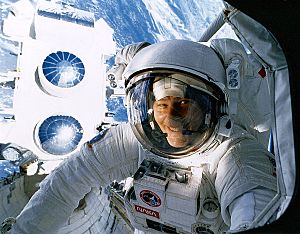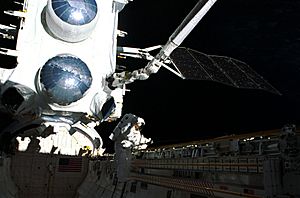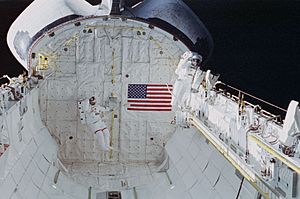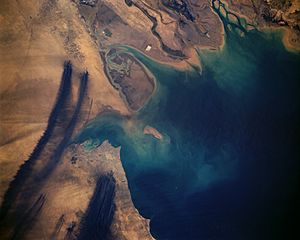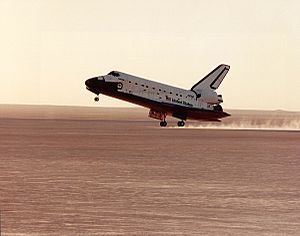STS-37 facts for kids
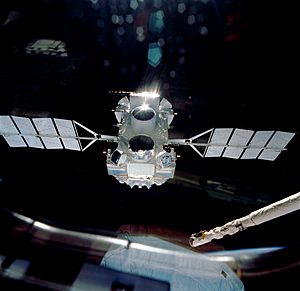
The Compton Gamma Ray Observatory after deployment, photographed from Atlantis's flight deck.
|
|
| Mission type | Satellite deployment |
|---|---|
| Operator | NASA |
| Mission duration | 5 days, 23 hours, 32 minutes, 44 seconds |
| Distance travelled | 2,487,075 mi (4,002,559 km) |
| Orbits completed | 93 |
| Spacecraft properties | |
| Spacecraft | Space Shuttle Atlantis |
| Launch mass | 116,040 kg (255,820 lb) |
| Landing mass | 86,227 kg (190,098 lb) |
| Payload mass | 17,204 kg (37,928 lb) |
| Crew | |
| Crew size | 5 |
| Members |
|
| EVAs | 2 |
| EVA duration | 10 hours, 29 minutes First: 4 hours, 32 minute Second: 5 hours, 57 minutes |
| Start of mission | |
| Launch date | 5 April 1991, 14:22:45 UTC |
| Rocket | Space Shuttle Atlantis |
| Launch site | Kennedy Space Center, LC-39B |
| Contractor | Rockwell International |
| End of mission | |
| Landing date | 11 April 1991, 13:55:29 UTC |
| Landing site | Edwards Air Force Base, Runway 33 |
| Orbital parameters | |
| Reference system | Geocentric orbit |
| Regime | Low Earth orbit |
| Perigee | 450 km (280 mi) |
| Apogee | 462 km (287 mi) |
| Inclination | 28.45° |
| Period | 93.70 minutes |
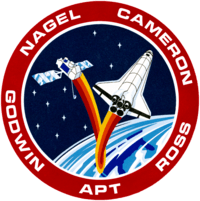 STS-37 mission patch 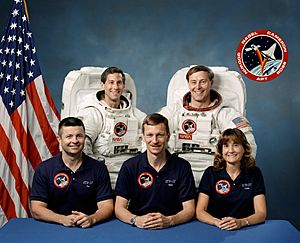 Back row: Kenneth D. Cameron, Jerome "Jay" Apt Seated: Steven R. Nagel, Jerry L. Ross, Linda M. Godwin |
|
STS-37 was an exciting six-day space mission by NASA's Space Shuttle Atlantis. It was the 39th Space Shuttle mission ever! The main goal was to launch a huge satellite called the Compton Gamma Ray Observatory (CGRO). This satellite was super important for studying the universe.
The mission also included two spacewalks. These were the first spacewalks by American astronauts since 1985. The crew worked hard to get the satellite ready and even fixed a problem with it in space!
Contents
Meet the Astronauts
| Position | Astronaut | |
|---|---|---|
| Commander | Steven R. Nagel Third spaceflight |
|
| Pilot | Kenneth D. Cameron First spaceflight |
|
| Mission Specialist 1 | Linda M. Godwin First spaceflight |
|
| Mission Specialist 2 | Jerry L. Ross Third spaceflight |
|
| Mission Specialist 3 | Jerome "Jay" Apt First spaceflight |
|
Spacewalks by Ross and Apt
Astronauts Jerry Ross and Jay Apt performed two spacewalks during this mission.
- First Spacewalk (EVA 1)
- Date: 7 April 1991
- Duration: 4 hours, 32 minutes
- Second Spacewalk (EVA 2)
- Date: 8 April 1991
- Duration: 5 hours, 57 minutes
Launching into Space
The STS-37 mission launched successfully on April 5, 1991. The Space Shuttle Atlantis lifted off from Kennedy Space Center in Florida. It launched from pad 39B at 9:22 AM Eastern Standard Time.
The launch was delayed a little bit. This was because of concerns about the weather. But everything was checked, and the launch went ahead safely. The Atlantis weighed about 116,040 kilograms (255,825 pounds) at launch.
The Compton Gamma Ray Observatory
The main reason for the STS-37 mission was to launch the Compton Gamma Ray Observatory (CGRO). This huge satellite was deployed on the third day of the mission.
The CGRO is part of NASA's Great Observatories program. This program includes other famous telescopes like the Hubble Space Telescope. The CGRO was designed to study gamma rays from space. Gamma rays are a type of energy that cannot get through Earth's atmosphere.
Fixing the Antenna
When the CGRO was deployed, its main antenna did not open properly. Astronauts Jerry Ross and Jay Apt had to go on an unplanned spacewalk to fix it! This was the first unplanned spacewalk since 1985. Ross was able to free the antenna boom in just 17 minutes.
The CGRO was very heavy, weighing about 16,000 kilograms (35,274 pounds). It was the heaviest satellite launched into low Earth orbit by the Space Shuttle at that time. It was also designed so that future Shuttle crews could refuel it in space.
Five months after it was launched, NASA renamed the satellite. It was named the Arthur Holly Compton Gamma Ray Observatory. This honored a Nobel Prize-winning physicist named Arthur Holly Compton.
Spacewalk Adventures
Astronauts Jerry Ross and Jay Apt completed two spacewalks. The first one was to fix the CGRO's antenna. Ground control tried many times to get the antenna to open. They even moved the Atlantis and its robot arm. But nothing worked.
Ross and Apt were ready for this kind of problem. Ross quickly freed the antenna boom. This unplanned spacewalk was a big success!
Testing for Future Space Stations
The next day, Ross and Apt did another spacewalk. This one was planned. They tested ways for astronauts to move around and carry equipment outside a future space station. At the time, NASA was planning to build Space Station Freedom.
They tried different ways to move carts on the outside of large structures. They used manual power, mechanical power, and electrical power. The astronauts found that moving the cart by hand worked best.
In total, Ross and Apt spent 10 hours and 29 minutes walking in space during STS-37.
A Small Problem
During the second spacewalk, Jay Apt's glove got a small hole. A metal bar poked it. But his hand and a silk glove inside helped seal the hole. So, no air leaked out! The astronauts didn't even notice the hole until after they landed.
Other Experiments on Board
Besides the main satellite, the mission carried other experiments. These included:
- CETA: Crew and Equipment Translation Aid, which was part of the spacewalks.
- APM: Ascent Particle Monitor, to study particles in space.
- SAREX II: Shuttle Amateur Radio Experiment, allowing astronauts to talk to amateur radio operators on Earth.
- PCG: Protein Crystal Growth, to grow protein crystals in space.
- BIMDA: Bioserve/Instrumentation Technology Associates Materials Dispersion Apparatus, for biomedical and manufacturing research.
- RME Ill: Radiation Monitoring Equipment, to measure radiation.
- AMOS: Air Force Maui Optical Site experiment.
Astronaut Kenneth Cameron was the main operator for the SAREX experiment. All five crew members talked to people on Earth using amateur radio. They even received live video from a ham radio club!
The crew also took amazing photos of the Kuwaiti oil fires from space. This was on April 7, 1991, during the Gulf War.
Landing Back on Earth
The Atlantis landed on April 11, 1991. It touched down at Edwards Air Force Base in California. The landing was originally planned for April 10, but it was delayed by one day due to bad weather.
The Shuttle landed a bit short of the runway's exact mark. But this was not a problem because it landed on the dry lake bed at Edwards. The Atlantis weighed about 86,227 kilograms (190,098 pounds) when it landed.
Mission Patch Symbolism
The STS-37 mission patch has special meanings. The three stars at the top and seven stars at the bottom represent the mission's number, 37.
The stars also stand for "73," which is an amateur radio term meaning "Best regards." This was a nod to the SAREX-II experiment. All the astronauts became licensed amateur radio operators for the mission!
Wake-Up Calls from Space
NASA has a fun tradition of playing music to wake up astronauts. This started during the Project Gemini missions. Each song is chosen carefully, often by the astronauts' families. The songs usually have a special meaning to one of the crew members.
| Day | Song | Artist/Composer | Played for |
|---|---|---|---|
| Day 2 | Music by Marching Illini Band | University of Illinois | Steven R. Nagel |
| Day 3 | "The Marine Corp Hymn" | U. S. Naval Academy band | Kenneth D. Cameron |
| Day 4 | "Hail Purdue" | Purdue University Band | Jerry L. Ross |
| Day 5 | "Ten Thousand Men of Harvard" | Harvard University Glee Club | Jerome "Jay" Apt |
| Day 6 | "La Bamba" | Brass Rhythm and Reeds | Linda M. Godwin |
| Day 7 | Magnum, P.I. theme with a greeting from Tom Selleck | Linda M. Godwin, a "big Selleck fan" |



